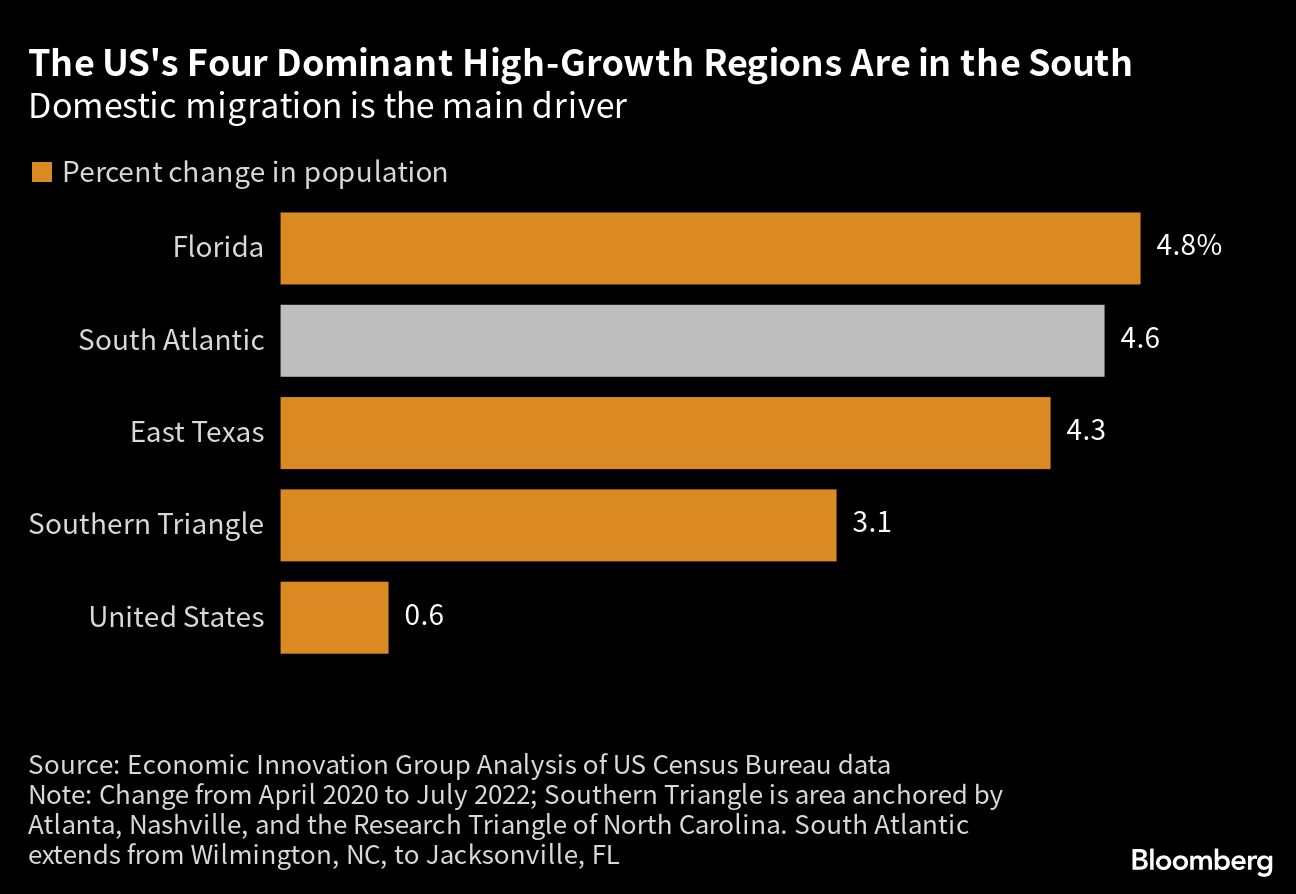Why $100B of Wealth Moved to the Southeast

On this vital link to the port, sandwiched between sensitive environmental lands, electric-vehicles plants and master-planned communities are replacing the forests managed by timber companies for decades.
On a March Friday evening, a couple dozen empty-nesters sipped chardonnay and bourbon at a newcomers club party in the Charleston suburb town of Mount Pleasant. Almost everyone seemed to be from New Jersey.
Beth Woods, 47, and her husband were eager to escape the Covid-19 shutdowns and shuttered stores up north, so they started making bi-weekly trips from Mount Olive, New Jersey, soon after the pandemic struck. Before long, they decided to make the move permanent.
“You could get your hair done, your nails done, you could basically live your life. And it has lower property taxes here, too,” Woods said.
A few feet away, Rosemary Taibi, 59, concurred. She and her husband slashed their property taxes to $2,000 from $16,000 after moving from Randolph, New Jersey: “It’s a big difference.”
Northeasterners are moving here, but, more surprisingly, so are Californians.
Employment in the Charleston metro area grew by 5.9% last year, twice as fast as the U.S. average. A Nevada company, Redwood Materials, is building a $3.5 billion EV-components plant 40 minutes northwest of Charleston, following a Volvo plant that opened five years ago.
Whether the growing conservative tilt on issues including reproductive rights could chip away at the influx of people willing to move to some southern states remains to be seen. There’s no evidence that it has slowed the flow of migration.
For now, more people translate into more congressional seats and more political power on the national scene.
Over the past five decades, 12 states in the Southeast including Texas collectively added 33 more congressional seats, roughly the same number that the Northeast and Midwest each lost over the same period.
And Southerners now chair 11 of the 21 most important committees in the U.S. House, according to an analysis by Bloomberg Government.
At the 2022 midterm elections, Republican governors handily defeated nationally known Democratic opponents in Florida, Georgia and Texas, a blow to Democrats hoping that a more diverse mix of people moving south would turn the region purple, if not blue.
That may still happen over the long term because shifting politics in states as big as Florida and Texas can take 10 or 20 years, said James Gimpel, government professor at the University of Maryland.
It’s not surprising, Gimpel said, that so many top Republican candidates are based in the South, including former President Donald Trump and Florida Governor Ron DeSantis, as well as Nikki Haley and Tim Scott, both in South Carolina.
For now, though, Maurice Washington, who recently stepped down as chairman of the Charleston County Republican Party, likes what he sees.
Over coffee and croissants in Charleston’s historic district, he said followers on his party’s social media sites jumped from 4,700 before the pandemic to almost 26,000, and he attributes much of it to all the transplants flooding here.
“They don’t want to raise their kids in places like New York and California. You get a lot of that,” Washington said.

Exacerbating Inequalities
For a century and a half, the South has struggled to overcome its position as America’s economic backwater. Even now, despite pockets of new prosperity, life across much of this region tends to be poorer and shorter than in most other parts of the country.
Nowhere arguably does the legacy of slavery and segregation run deeper.
Washington has seen the changes — good and bad — up close. The transplant-driven gentrification is pushing rents and home prices out of reach for many and hallowing out Charleston’s Black community, said Washington, who is African American.
When he first joined the City Council in 1990, Blacks made up 42% of the population. It’s since been halved to 20%, according to Census Bureau data.
Across the Cooper River from downtown Charleston, African Americans of Gullah descent recently hauled a 119-year-old schoolhouse for African Americans to a spot two miles from Boone Hall Plantation, the still-operating plantation where some of their enslaved ancestors once labored.
They’re preserving a bit of history lest it get bulldozed for a new highway. It hopefully will open to the public next year after extensive fixes, said John Wright, president of the African American Settlement Community Historic Commission.
“If you live in a community void of your culture and your history, then you’re no longer a community,” said Fred Lincoln, a board member on the commission.
In Nocatee, Florida, just south of Jacksonville, the inequalities and poverty still so prevalent in the South were hard to spot. The median sale price of a single-family home here has climbed 62% to $773,500 in three years, according to housing marketplace Redfin.
Schools are considered tops in the state, and golf carts are so ubiquitous on local streets that a Publix supermarket has parking spaces for them.
Steven Hertzberg, a tech entrepreneur, moved from Sonoma County, California, with his family 15 months ago and now works out of The Link, a tech-oriented co-working space in St. Johns County that offers dance classes and yoga for families.
“Just drive around the neighborhoods here. It feels like you’re in Disneyland,” Hertzberg said. “You see teenagers winging around in golf carts, electric scooters.”
–With assistance from Amanda L Gordon, Kyle Kim, Andre Tartar and Reade Pickert.
(Image credit: Thinkstock)




